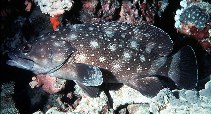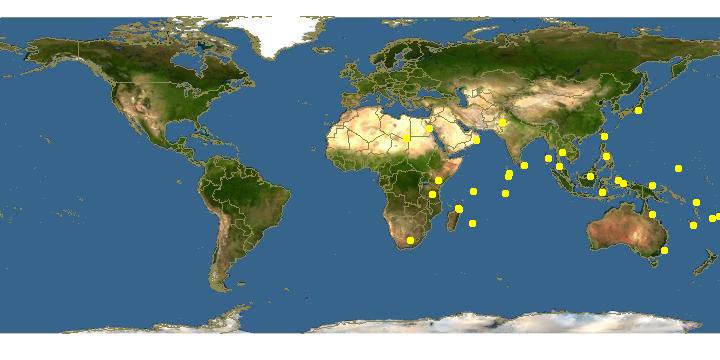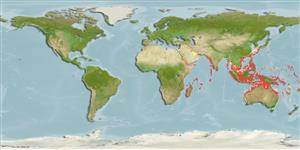http://www.fishbase.org/Summary/speciesSummary.php?genusname=Epinephelus&speciesname=coeruleopunctatus ---> http://192.134.151.83/Summary/speciesSummary.php?genusname=Epinephelus&speciesname=coeruleopunctatus
http://192.134.151.83/Summary/speciesSummary.php?genusname=Epinephelus&speciesname=coeruleopunctatus ---> https://fishbase.mnhn.fr/Summary/speciesSummary.php?genusname=Epinephelus&speciesname=coeruleopunctatus
https://fishbase.mnhn.fr/Summary/speciesSummary.php?genusname=Epinephelus&speciesname=coeruleopunctatus ---> https://fishbase.mnhn.fr/summary/Epinephelus-coeruleopunctatus.html
Epinephelus coeruleopunctatus, Whitespotted grouper : fisheries

You can
sponsor
this page
Common name (e.g. trout)
Genus + Species (e.g. Gadus morhua)
-

-
About this page
-
Languages
-
User feedbacks
-
Citation
-
Uploads
-
Related species
-


 Whitespotted grouper
Add your observation in
Fish Watcher
Upload your
photos
and
videos
Whitespotted grouper
Add your observation in
Fish Watcher
Upload your
photos
and
videos
Pictures
|
Videos |
Google image
 Epinephelus coeruleopunctatus
Epinephelus coeruleopunctatus
Picture by
Randall, J.E.
Teleostei (teleosts) >
Perciformes/Serranoidei
(Groupers) >
Epinephelidae
(Groupers)
Etymology:
Epinephelus:
Greek, epinephelos = cloudy (Ref.
45335
)
.
More on author:
Bloch
.
Environment: milieu / climate zone / depth range / distribution range
Ecology
Marine; reef-associated; depth range 2 - 65 m (Ref.
9710
). Tropical; 35°N - 35°S, 26°E - 180°E (Ref.
5222
)
Indo-Pacific: East Africa south to East London, South Africa and east to Fiji. Recently recorded from Tonga (Ref.
53797
). It is not known from the Red Sea, but it does occur in the Persian Gulf. Record from northwestern Australia (Ref.
3132
) is doubtful. It is closely related to, and is often confused with, three other white-spotted species:
Epinephelus ongus
,
Epinephelus summana
, and
Epinephelus corallicola
.
Length at first maturity / Size / Weight / Age
Maturity: L
m
?
, range 42 - ? cm
Max length : 76.0 cm TL male/unsexed; (Ref.
6492
)
Dorsal
spines
(total): 11;
Dorsal
soft rays
(total): 15-17;
Anal
spines
: 3;
Anal
soft rays
: 8. This species is distinguished by the following characters: body depth distinctly less than head length, 2.9-3.4 in SL (for specimens 11-47 cm SL); head length 2.3-2.5 in SL; head pointed, dorsal profile almost straight; preopercle rounded, finely serrate; opercular spines inconspicuous; upper edge of operculum straight, sinuous or slightly convex; maxilla naked, mostly covered by upper lip; small or absent canines at front of jaws; midlateral part of lower jaw with 3-5 rows of small teeth; gill rakers of first gill arch 8-10 + 13-17 in juveniles and 4-8 in upper limb for adults larger than 25 cm SL; adults with ctenoid scales on body in broad zone along middle of side, cycloid elsewhere and with numerous auxiliary scales; caudal fin rounded; pectoral fins large and fleshy, with 17-19 rays, the fin length 1.5-2.1 in HL; short pelvic fins, not reaching anus, 2.0-2.7 in head length. Colour of adults brownish grey, the body covered with small pale spots overlain with large pale blotches; oblique black saddle on rear half of peduncle; 4-5 indistinct black blotches at base of dorsal fin; prominent black streak on maxillary groove; large adults brownish, covered with small, indistinct, contiguous pale spots; juveniles (less than 25 cm) dark grey to black, covered with prominent pupil-size white spots and smaller white dots (Ref.
39231
,
89707
,
90102
).
Occurs in rocky or coral-rich areas of deep lagoons, channels and outer reef slopes; usually in or near caves (Ref.
089707
). Solitary (Ref 90102). Juveniles are found in tide pools. Feeds on fish and crustaceans (Ref.
6113
). In Hong Kong live fish markets (Ref.
27253
). Caught with hook-and-line, spear, and in traps and probably of some importance to fisheries in areas where it is common (Ref.
39231
).
Life cycle and mating behavior
Maturity
|
Reproduction
|
Spawning
|
Eggs
|
Fecundity
|
Larvae
Heemstra, P.C. and J.E. Randall
, 1993. FAO Species Catalogue. Vol. 16. Groupers of the world (family Serranidae, subfamily Epinephelinae). An annotated and illustrated catalogue of the grouper, rockcod, hind, coral grouper and lyretail species known to date. Rome: FAO. FAO Fish. Synop. 125(16):382 p. (Ref.
5222
)
IUCN Red List Status (Ref.
130435
)
Least Concern (LC)
; Date assessed:
16 November 2016
CITES
Not Evaluated
Not Evaluated
Threat to humans
Harmless
Human uses
Fisheries: minor commercial
FAO - Publication:
search
|
FishSource
|
Sea Around Us
More information
Countries
FAO areas
Ecosystems
Occurrences
Introductions
Stocks
Ecology
Diet
Food items
Food consumption
Ration
Common names
Synonyms
Metabolism
Predators
Ecotoxicology
Reproduction
Maturity
Spawning
Spawning aggregation
Fecundity
Eggs
Egg development
Age/Size
Growth
Length-weight
Length-length
Length-frequencies
Morphometrics
Morphology
Larvae
Larval dynamics
Recruitment
Abundance
BRUVS
References
Aquaculture
Aquaculture profile
Strains
Genetics
Electrophoreses
Heritability
Diseases
Processing
Nutrients
Mass conversion
Collaborators
Pictures
Stamps, Coins Misc.
Sounds
Ciguatera
Speed
Swim. type
Gill area
Otoliths
Brains
Vision
Tools
Bio-Quiz
|
E-book
|
Field guide
|
Identification keys
|
Length-frequency wizard
|
Life-history tool
|
Point map
|
Classification Tree
|
Catch-MSY
|
Special reports
Check for Aquarium maintenance
|
Check for Species Fact Sheets
|
Check for Aquaculture Fact Sheets
Download XML
Summary page
|
Point data
|
Common names
|
Photos
Internet sources
AFORO (otoliths)
|
Aquatic Commons
|
BHL
|
Cloffa
|
BOLDSystems
|
Websites from users
|
Check FishWatcher
|
CISTI
|
Catalog of Fishes
:
genus
,
species
|
DiscoverLife
|
ECOTOX
| FAO - Publication:
search
|
Faunafri
| Fishipedia |
Fishtrace
| GenBank:
genome
,
nucleotide
|
GloBI
|
Google Books
|
Google Scholar
|
Google
| IGFA World Record |
MitoFish
|
National databases
|
Otolith Atlas of Taiwan Fishes
|
Public aquariums
|
PubMed
|
Reef Life Survey
|
Socotra Atlas
|
Tree of Life
| Wikipedia:
Go
,
Search
| World Records Freshwater Fishing |
Zoological Record
Estimates based on models
Preferred temperature (Ref.
123201
): 24.6 - 29, mean 28 °C (based on 1234 cells).
Phylogenetic diversity index (Ref.
82804
): PD
50
= 0.5000 [Uniqueness, from 0.5 = low to 2.0 = high].
Bayesian length-weight: a=0.01122 (0.00705 - 0.01786), b=3.00 (2.87 - 3.13), in cm total length, based on LWR estimates for this species & Genus-body shape (Ref.
93245
).
Trophic level (Ref.
69278
): 3.7 ±0.5 se; based on diet studies.
Resilience (Ref.
120179
): Low, minimum population doubling time 4.5 - 14 years (Preliminary K or Fecundity.).
Fishing Vulnerability (Ref.
59153
): Moderate to high vulnerability (50 of 100).
Climate Vulnerability (Ref.
125649
): High to very high vulnerability (66 of 100).
Price category (Ref.
80766
):
Very high
.
Nutrients (Ref.
124155
): Calcium = 21.4 [10.4, 48.2] mg/100g; Iron = 0.447 [0.241, 0.902] mg/100g; Protein = 18.5 [16.9, 19.9] %; Omega3 = 0.112 [0.069, 0.178] g/100g; Selenium = 39 [23, 70] μg/100g; VitaminA = 150 [42, 536] μg/100g; Zinc = 1.24 [0.87, 1.72] mg/100g (wet weight);
Back to Search
Random Species
Back to Top
Accessed through:
Not available
FishBase mirror site :
localhost
Page last modified by :
mrius-barile
- 20 July 2016
Fatal error
: Uncaught ArgumentCountError: Too few arguments to function checkEcotox(), 1 passed in /var/www/html/summary/speciessummary.php on line 2304 and exactly 3 expected in /var/www/html/includes/speciessummary.lib.php:2579 Stack trace: #0 /var/www/html/summary/speciessummary.php(2304): checkEcotox() #1 {main} thrown in
/var/www/html/includes/speciessummary.lib.php
on line
2579
|






